uroplatus phantasticus care sheet
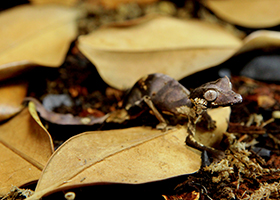

Introduction
Uroplatus phantasticus are a gecko species endemic to Madagascar from the genus Uroplatus. Uroplatus phantasticus are one of the smallest species within the genus Uroplatus, with an average adult length of 4-5” from snout to tail tip. Uroplatus are commonly called Leaf Tail or Flat Tail geckos. Phantasticus are sometimes labeled as Satanic Gecko, Fantastic Gecko, or Eyelash Gecko, although most commonly they are referred to as Phantasticus. Being in the Genus Uroplatus, Phantasticus have evolved to mimic leaves. Their tails have the shape, coloration, veins, notching, and lichen commonly found in their natural environment. Unlike many in the Genus, Phantasticus have evolved to mimic dead or dying plant matter instead of branches and living vegetation. Their unique appearance and size have made them one of the most desired gecko species available. Although anyone is capable of acquiring Phantasticus, they are considered a difficult species (to keep and reproduce) and should only be acquired once adequate information and species understanding is achieved. There isn’t a “right” way to keep Phantasticus, but there are a number of variables which produce a negative effect on the gecko. Throughout this care sheet, I will be discussing some of the requirements, as well as my personal experiences with keeping, reproducing, and subsequently raising Uroplatus phantasticus. I also suggest reading Leaf-Tailed Geckos - The Genus Uroplatus by Sascha Svatck and Susanna van Duin .


Purchasing
When looking to purchase Uroplatus phantasticus there are a few factors to consider before making your decision. The most important things to consider are: if the animal is CB (captive bred) or WC (wild caught), the level of knowledge of the breeder/seller, and the general health of the gecko. While browsing for U. phantasticus, you may notice a significant difference in price between CB and WC. This is where most people go wrong with their decision. Wild caught geckos tend to be more sensitive to husbandry errors due to the stress of captivity and the typical health problems with WC animals (parasites, hydration, unknown background, etc.).That is not to say all WC are unhealthy or a bad option, just that they come with additional risks and should be obtained by experienced keepers. On average, a CB phantasticus will retail for $300-$400 each. Prices may vary based on phenotypic demand, visual defects (dropped tails, kinks, etc.), or simply supply and demand for the year. When comparing phenotypes, many refer to certain traits as “common” or “standard”, which is a false perception on the true variability capable from each individual gecko. Yes, some colors in particular appear more common than others, but these geckos (from my experience) are fully capable of reproducing a wide array of phenotypes and vise versa. Another consideration prior to making your decision is the experience and understanding of the species of the individual/business who is selling them. U. phantasticus are a species that require more than book knowledge to truly understand. Experience throughout multiple seasons of learning the pros and cons of husbandry techniques will provide a tremendous amount of insight and understanding of the species, which in turn correlates to healthier animals. This is not to say a first time breeder is not a good source to obtain your gecko from, it simply means that their knowledge of the species should be able to satisfy all of your questions pertinent to the animals well being. Additionally, having a reliable source to refer back to throughout your learning experience will greatly increase your success rates with reproduction.
Habitat
There is more than one correct way to house your Phantasticus, but there are a few requirements to ensure your geckos’ needs are met. Like other species in the Genus, Phantasticus are predominantly an arboreal species. We suggest using vertical enclosures that still provide adequate substrate exposure. We have had the best success with 12x12x18 or 18x18x24 glass enclosures (depending on age/size of the pairs being housed with most being housed in the 12x12x18). Unlike most others in the Genus, Phantasticus have evolved to mimic dead or dropped leaves instead of branches and live plant matter. For this reason I cannot stress enough how important the development and enrichment in the bottom 1/3 of the enclosure is for this species.
Coming from the montane forest of Madagascar, U. phantasticus prefer cooler temperatures with high humidity. These temperatures range from 70-75°F (21-24°C) during the day and a night temp between 68-72°F (20-22°C) during summer months. I do not recommend cooling Phantasticus, but I do allow our temperatures to drop 2-3°F during the Winter months with gradual warming periods in Spring and cooling periods in Fall. Temperatures below 65°F (18°C) and above 80°F (26.6°C) are not safe and should be avoided, even for short durations. With such a small window of optimal temperatures and need of cooler temperatures, I do not recommend a basking light for this species. Humidity should be maintained between 70-85% year round. I have found that a slight drying out of the enclosure (60-70% humidity) during late afternoon with a heavy mist/rain (85% humidity) as lights go out to be the most effective. You want to maintain adequate air exchange while maintaining humidity to help prevent mold and stagnant air from accumulating. Be sure not to mistake enclosure humidity with an enclosure being saturated. Misting will be discussed in feeding and water.
There are many options when it comes to substrate and a few factors to consider when choosing an appropriate substrate. The most important factor is the ability for the substrate to retain moisture (helps maintain humidity). Certain substrates can also be utilized by living plants within the enclosure (live plants are not necessary, but highly suggested). Most females will dig shallow holes while nesting. Ensuring your substrate allows for safe nesting will help encourage females to reproduce. Lastly, does the substrate allow for feeders to bury or hide too easily? This tends to be more of an issue when using various mosses as your primary substrate media. There are several commercially available options such as Sphagnum Moss, Peat Moss, Coco coir, Bed-A-Beast, ABG (or similar mixes), etc. Although none of these are immediately better than the other, I do prefer an ABG style substrate to the others. That being said, as long as your substrate complies with the above listed factors, that would be sufficient. On top of the substrate should be a layer of leaf litter. U. phantasticus do spend portions of their nights prowling through the leaves and often utilize them as shelter for nesting sites. I have found a disbursement of leaf litter on roughly 1/2 the floor space to be an adequate coverage without providing too much cover for feeders to hide.
There are 3 ways of planting a U. phantasticus enclosure: real, artificial, or a combination of both. Although there isn't a wrong way, the least preferred is the exclusive use of artificial plants. Artificial plants provide cover and enrichment but they do not help with humidity or air quality within the enclosure. When selecting plants for the enclosure, you have to first determine what is safe and best for the Phantasticus. I have found a combination of Pothos and Ficus to be the best options. These plants are hardy, strong enough to support movement, safe for the geckos, help retain humidity, and are easily obtained. Never choose a plant species which may be toxic if ingested, even though Phantasticus are not herbivores. Most plants will have pesticide residue on their leaves and should be washed thoroughly prior to being placed within the enclosure. When selecting your plants, look for healthy plants free of insects or fungus. The use of artificial plants should only be used to fill in some of the dead space and additional enrichment throughout the enclosure.
The last component of cage décor is the branches and sticks. These help allow access and mobility throughout the entire enclosure. When selecting branches for your enclosure, you want to first begin by ensuring that they are free of parasites or other organisms that you do not want to introduce into the enclosure. Whether you are purchasing or collecting branches, thoroughly clean and inspect them to prevent any introduction of unwanted foreign matter. There are many techniques for cleaning the branches, and all are relatively equal in effectiveness. Make sure any residues from cleaning agents are removed prior to placement within the enclosure (as the geckos may drink droplets formed on the branches). The diameter of the branches should be 1/2"-5/8" or roughly the width of the gecko. The use of commercially available flexible vines is not necessary, but may be ideal for filling in the top 1/3 area of the cage to allow for full mobility of the enclosure.
The use of UV lighting is something that is always up for debate and valid points are made from both sides. I use full spectrum lighting for the live plants within the enclosures, which also serve as the lighting for the room. Although I use UV lighting, I wouldn't say UV lighting is necessary for U. phantasticus. Lighting is still beneficial in simulating photoperiods (the length of daylight based on season) and meeting the plant requirements. Even with lighting, the use of supplements should remain a constant for your care. There will be a discussion on supplementation in the feeding section.
| Habitat Recap: | |
|---|---|
• 12x12x18 enclosure (minimum size for adults) • 70-75°F (21-25°C) Temperature with 70-85% Humidity • ABG (or similar) substrate • Leaf litter • Living and artificial plants • 1/2-5/8" branches vertical and angled • Suspended vine (top 1/3 enrichment)* • UV light * • Misting system (automatic or manual) * • Thermometer* • Hygrometer*
* Optional items that may vary in importance based on your conditions and specifics to your abilities to achieve an ideal environment. |
|



feeding and supplementation
When it comes to feeding your U. phantasticus, there is not a specific feeder that is the “best” option. In general, I feed a combination of adequately sized crickets, roaches, and a constant supply of isopods are kept within the enclosure. Adults generally feed on 1/2" crickets, adult Lateralis, and juvenile Dubia. Babies are generally offered Lateralis and Dubia nymphs and 1/8"-1/4" crickets. The general rule for appropriate sizing is no larger than the width of the geckos’ neck. A large majority of U. phantasticus take to dish feeding relatively well, as long as there is a contrast between the dark feeder and the dish they are in. I have had great success using white disposable worm dishes. The lip reduces the number of feeders escaping the dish. How much should you be feeding them? I prefer to grow my Phantasticus slow and keep them lean. I have found that growing them too fast and keeping them "fat and happy" resulted in a significant decrease in fertility and annual clutch counts. I do not follow a feeding regimen but instead feed each enclosure as needed. Supplying enough feeders to last 2-3 days and allowing the absence of feeders for a period of 1-2 days has proven to be a good routine for maintaining healthy weight and supporting a steady growth. The only deviation is the first 2 weeks after a female lays a clutch. During this time, I will feed daily with only 3-4 feeders. This helps ensure the females are getting adequate supplementation during their breeding season. Babies follow a similar feeding regimen with reduced numbers of feeders offered each feeding based on consumption rate. Additional information on raising babies can be found in the Babies section.
Supplementation is essential for Uroplatus phantasticus in captive care. Over the years, I have tried numerous supplements and combinations of them in search for the most effective. A mixture of Sticky Tongues Miner-All, Repashy Calcium +, and Bee pollen powder in a ratio of 4:1:0.25 respectively has worked wonders for my U. phantasticus. Although this is one of the many options, this blend has produced great reproduction and developmental results for me over multiple seasons. The feeders should be dusted every feeding (if using the method stated above) unless you are feeding more than 3 times a week, at which point a 2-3 dustings a week is sufficient. In addition to supplementing with topical powders, a feeder gutload is highly recommended. The point behind gutloading is simply to ensure the feeders are as healthy as possible and contain higher vitamin and mineral content than a grain based diet. Dark leafy greens, fruit, vegetables, and whole grains are all good feeder options. There are some commercially available options, but they should be used in conjunction with fresh vegetables and fruits.


breeding
Before you can begin pairing your U. phantasticus, you have to ensure you actually have a male and a female. There are a couple phenotypic expressions which are relatively accurate forms of sexing Phantasticus. Females tend to have smooth tails (free of notches), drab coloration, lack of “bulges”, and smaller/less pronounced tubercles. Males tend to have a white "tear drop" shape under their eyes, notched tails, pronounced tubercles, brighter and bolder colors and patterns, and the presence of a "bulge" near the cloaca. Once you have determined you have a pair, consider their age. I have found that age is a far better guide for breeding than weight. I don't pair U. phantasticus until the geckos are a minimum of 18 months of age. When you begin to pair your geckos together, I have found greater success in the first season by introducing the male into the female’s enclosure. After I have decided the pairings for the year, I will leave the pairs together throughout the entirety of the season and into the "cooling"/fall months. It is normal to witness some biting and tails waving, however, if the female is unreceptive to the male’s advances, remove the male to prevent added stress or autotomy. Signs of an unreceptive female may be biting/attacking the male, arching her back while waving her tail, leaping away from the male when he approaches her, and a gaping mouth.
| Males | Females |
|---|
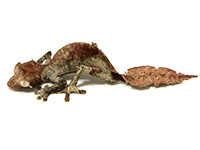
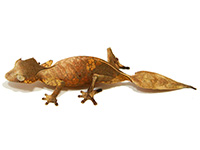

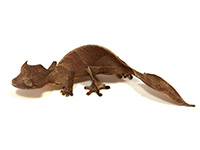
Once the pair has successfully copulated, you may or may not notice an abdominal distension in the female, but will likely notice the female more terrestrial or increased time spent in the bottom 1/3 of the enclosure. This is when your enclosure setup comes into effect. With adequate leaf litter and the substrate lightly damp, your female will determine the best place for her to deposit her clutch. Occasionally, females will deposit their clutch at the base of branches, plants, or other décor, but typically will lay their clutches under the leaf litter. During this time, I do not offer food or simulate any "heavy rains" by increased misting times so I won't disturb or potentially damage the eggs. Fertile eggs are literally about the size of a pea with a thin hard outer shell. Sometimes an infertile egg will appear fertile until the egg is candled.
Candling U. phantasticus can be a bit of a challenge and misleading during the first 2 weeks of incubation due to the minimal embryo visibility and slow development. As a precaution, I incubate every egg that looks fertile and then candle them 2 weeks later to check for embryo growth and confirm fertility. In the event of egg infertility which never calcified, your female will produce "slugs". Slugs are infertile eggs which tend to be yellow/egg white in color and of a soft and sticky texture. Most females will deposit slugs on leaves or on the sides of the enclosure. These can be removed easily once dried. Slugs do occur in fertile pairs and should not be cause for concern, unless a female only produces slugs for an entire season. In the event that a female only produces slugs, I would try pairing her with a different male the following season (ideally a proven male if possible).


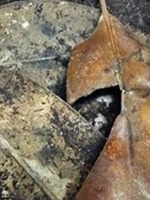
incubation
Uroplatus phantasticus generally deposit 2 eggs per clutch and 3-6 clutches per year. Collecting the pea sized hard shell eggs can be a tricky and delicate process (especially if you have large hands like me). One tool that may help in your retrieval would be the use of a plastic spoon to retrieve the eggs and remove them from the enclosure where you can take additional precautions not to damage the eggs. Once you have collected the eggs, you now have to set them up for their incubation period. There are many ways in which to set up your U. phantasticus eggs in their incubation container. You can have direct contact or suspension methods with an array of substrate options. Some of the most common incubation media are vermiculite, hatch rite, sphagnum moss, ceramic pebbles, bed-a-beast, etc. All of these are suitable options and can produce similar hatch rates. I have had the best success using a non-direct contact method which keeps the eggs separate from the incubation media. This can be achieved using thin screen, suspension incubation containers, or simply a small piece of foam. If using the suspension method, the media saturation should be slightly wetter than a 1:1 ratio of water to media. I have never utilized a direct contact method or heard of a ratio suggested for Phantasticus incubated directly on the incubation media. While using the suspension method, the eggs do not come into contact with the media, the saturation level is nearly irrelevant as a variable for error. Incubation temperatures range from 70-75°F (21-25°C) and maintain 70-80% humidity. On average, it will take 90 days for the eggs to hatch. I do not suggest incubating within the enclosure. Although this is an option, you are allowing a significant number of additional variables, which only reduce your success rate and hatchling health.


hatchling care
This is by far the most delicate part of reproducing Uroplatus phantasticus. Proper hatchling care requires a great deal of attention to detail, planning, and continuous evaluation. Everyone has seen some of the amazing Phantasticus pairs being posted, clutches that follow, and even the baby pictures, but why doesn’t the available market ever seem to represent the production volume? The answer is simply due to husbandry and the sheer frailty of baby Phantasticus. Many of the baby Phantasticus you see posted, sadly, never make it past a couple weeks of age. Having made many changes over the years to adjust to my specific conditions, I now have nearly a 95% survival rate of all Phantasticus I produce (which isn't perfect, but it's far better than where I started).
I house hatchlings in 32oz vertical deli cups. Roughly 10 holes are drilled on the bottom of each cup to allow for drainage. Having tried many different substrates, I have found that during the first 2 months or so it was best to keep them on Sphagnum Moss. This is primarily due to its ability for drainage while remaining moist enough for sufficient humidity. Sphagnum is also more forgiving for the clumsy feeding of most Phantasticus babies. I use 2-3 sticks roughly 1/4-3/8 thick that span from the substrate to about 1/2" from the lid. The gap from the top reduced the number of feeders that overwhelm the lid and stick tops. Phantasticus typically do not hunt feeders on the screen tops, since they are ambush hunters. I use 3 leaf clusters from fake plants, usually Exo Terra Amapallo Forest Shrub. Why 3? I found it allowed enough space for hiding, surface area for water droplets, and it fills 2/3 of the lower portions of the container well. The lids have pre-drilled holes as well as a stainless steel mesh. These lids are frequently used for shipping insects and can be purchased from most reptile shipping companies. These lids help maintain humidity with a fine mesh screen that prevent tiny feeders from escaping. I keep and raise babies based on clutch data, meaning if it was a pair, then I keep the pair in the same cup. If it was a lone egg, I keep them isolated and separate throughout their maturity in my care.
| Quick Hatchling Recap: | |
|---|---|
• Sphagnum is changed every 3-4 weeks • Mist 2 times a day (until I see water drip out of the drainage holes) • Misting water is kept roughly 78 degrees • Keep them 72-74 day and 68-70 night • Feed pin heads, rusty red babies, and springtails (have seen them eaten but not really a source of sustainable nutrients) dusted with every feeding |
|
The babies are kept in these containers for roughly 2-3 months before they are transferred into small cricket keepers. This is all dependent on the individual animal’s growth, health, size, etc. At about 2-3 months, I begin to change a few things. The substrate is switched to ABG style mix but temperatures and misting regime remain the same. Decor is adjusted to include more stick or twigs of adequate diameter with most being angled, with a couple horizontal. I usually use size small fake plants (same type as above) or other plants which do not consume more than 1/3-1/2 the enclosure. Leaving open space is needed for air flow and exchange and enough branch space for exploration, sleeping, and hunting. Feeder sources vary a bit, as I then begin to offer isopods, crickets, and roaches more regularly. Everything-except isopods-is dusted every feeding and isopods are left in enclosures, regardless if eaten or not.

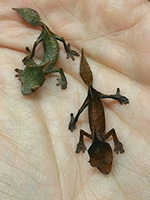

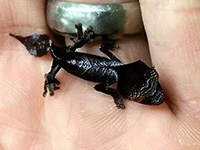
common hatchling problems
One of the most common problems I see with raising babies is keeping them too wet or too dry. Either extreme is counterproductive and detrimental for the baby. Animals with excessive air flow usually have shed issues and failed to thrive. Misting with water that is too cold will often shock the animals and increase their stress levels. Adequate supplementation is an easily avoidable variable and should be done with every feeding. Lastly, you have to refrain from holding or disturbing them as much as possible. Although they are an amazing species and the tiny babies are cute, do not unnecessarily agitate them.
Conclusion
Hopefully this care sheet has provided helpful insight and information about keeping Uroplatus phantasticus. Although there are some challenges in keeping Phantasticus, there are very few species as rewarding and beautiful as them. If you have any further questions about keeping and breeding Uroplatus phantasticus, please feel free to contact me HERE.
